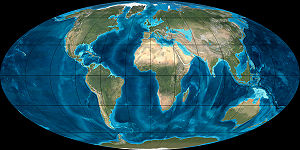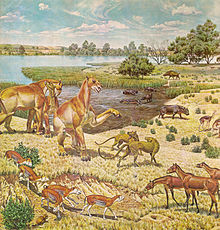- Miocene
-
System Series Stage Age (Ma) Quaternary Pleistocene Gelasian younger Neogene Pliocene Piacenzian 2.588–3.600 Zanclean 3.600–5.332 Miocene Messinian 5.332–7.246 Tortonian 7.246–11.608 Serravallian 11.608–13.65 Langhian 13.65–15.97 Burdigalian 15.97–20.43 Aquitanian 20.43–23.03 Paleogene Oligocene Chattian older Subdivision of the Neogene Period according to the IUGS, as of July 2009. The Miocene (symbol MI[1]) is a geological epoch of the Neogene Period and extends from about 23.03 to 5.332 million years ago (Ma). The Miocene was named by Sir Charles Lyell. Its name comes from the Greek words μείων (meiōn, “less”) and καινός (kainos, “new”) and means "less recent" because it has 18% fewer modern sea invertebrates than the Pliocene. The Miocene follows the Oligocene Epoch and is followed by the Pliocene Epoch. The Miocene is the first epoch of the Neogene Period.
The earth went from the Oligocene Epoch through the Miocene and into the Pliocene as it cooled into a series of Ice Ages. The Miocene boundaries are not marked by a single distinct global event but consist rather of regional boundaries between the warmer Oligocene and the cooler Pliocene.
The plants and animals of the Miocene were fairly modern. Mammals and birds were well-established. Whales, seals, and kelp spread. At the end of this epoch, the Himalayas started to rise.
Contents
Subdivisions
The Miocene faunal stages from youngest to oldest are typically named according to the International Commission on Stratigraphy:[2]
Messinian (7.246–5.332 Ma) Tortonian (11.608–7.246 Ma) Serravallian (13.65–11.608 Ma) Langhian (15.97–13.65 Ma) Burdigalian (20.43–15.97 Ma) Aquitanian (23.03–20.43 Ma) These subdivisions within the Miocene are defined by the relative abundance of different species of calcareous nanofossils (calcite platelets shed by brown single-celled algae) and foraminifera (single-celled protists with diagnostic shells). Two subdivisions each form the Early, Middle and Late Miocene.
Regionally, other systems are used. These ages often extend across the ICS epoch boundary into the Pliocene and Oligocene:
Australia
Australian Miocene ages are very finely divided in the early Middle Miocene, while most of the rest of the Miocene had a rather constant fauna as far as is known:[2]
Mitchellian (10.5–5 Ma); extends into the Early Pliocene Bairnsdalian (15–10.5 Ma) Balcombian (15.5–15 Ma) Batesfordian (16.5–15.5 Ma) Longfordian (27.5–16.5 Ma); includes much of the Late Oligocene California
Californian sites provide a sequence distinct from the main North American one:[2]
Delmontian (7.5 –2.9 Ma); includes much of the Pliocene Mohnian (13.5–7.5 Ma) Luisian (15.5–13.5 Ma) Relizian (16.5–15.5 Ma) Saucesian (22–16.5 Ma) Zemorrian (33.5–22 Ma); includes nearly all the Oligocene Japan
Japanese Miocene ages only start in the mid-Burdigalian; the ICS ages are used in much of the Early Miocene:[2]
Yuian (9.5–3.6 Ma); includes the Early Pliocene Fujian (11.1–9.5 Ma) Kaburan (13.5–11.1 Ma) Tozawan (15.97–13.5 Ma) Haranoyan (18.2–15.97 Ma) New Zealand
In New Zealand, the following ages are recognized:[2]
Kapitean (6–4.8 Ma); extends into the Early Pliocene Tongaporutuan (10–6 Ma) Waiauan (11.5–10 Ma) Lillburnian (15–11.5 Ma) Cliffdenian (16.5–15 Ma) Altonian (17.5–16.5 Ma) Awamoan (20–17.5 Ma) Hutchinsonian (21–20 Ma) Otaian (23.03–21 Ma) North America
In most of North America, faunal stages are defined according to the land mammal fauna (North American Land Mammal Ages or NALMAs):[2]
Hemphillian (9–4.75 Ma); includes much of the Early Pliocene Clarendonian (11.8–9 Ma) Barstovian (15.5–11.8 Ma) Hemingfordian (19–15.5 Ma) Arikareean (30.5–19 Ma); includes much of the Oligocene South America
In South America, a system similar to the North American one is used; its periods are correspondingly called SALMAs (South American Land Mammal Ages):[3]
Huayquerian (9–5.4 Ma); the Montehermosan barely extends into the Pliocene Chasicoan (10–9 Ma) Mayoian (12–10 Ma) Laventan (13.8–12 Ma) Colloncurian (15.5–12 Ma) Friasian (16.3–15.5 Ma) Santacrucian (17.5–16.3 Ma) Colhuehuapian (21–17.5 Ma) Deseadan (29–21 Ma); includes much of the Oligocene Paleogeography
Continents continued to drift toward their present positions. Of the modern geologic features, only the land bridge between South America and North America was absent, although South America was approaching the western subduction zone in the Pacific Ocean, causing both the rise of the Andes and a southward extension of the Meso-American peninsula.
Mountain building took place in Western North America, Europe, and east Asia. Both continental and marine Miocene deposits are common worldwide with marine outcrops common near modern shorelines. Well studied continental exposures occur in the American Great Plains and in Argentina.
India continued to collide with Asia, creating dramatic new mountain ranges. The Tethys Seaway continued to shrink and then disappeared as Africa collided with Eurasia in the Turkish-Arabian region between 19 and 12 Ma. The subsequent uplift of mountains in the western Mediterranean region and a global fall in sea levels combined to cause a temporary drying up of the Mediterranean Sea (known as the Messinian salinity crisis) near the end of the Miocene.
The global trend was towards increasing aridity caused primarily by global cooling reducing the ability of the atmosphere to absorb moisture. Uplift of East Africa in the Late Miocene was partly responsible for the shrinking of tropical rain forests in that region, and Australia got drier as it entered a zone of low rainfall in the Late Miocene.
Life
Flora
Grasslands underwent a major expansion; forests fell victim to a generally cooler and drier climate overall. Grasses also diversified greatly, co-evolving with large herbivores and grazers, including ruminants. Between 7 and 6 million years ago, there occurred a sudden expansion of grasses which were able to assimilate carbon dioxide more efficiently but were also richer in silica, causing a worldwide extinction of large herbivores.[4] The expansion of grasslands and radiations among terrestrial herbivores such as horses can be linked to fluctuations in CO2.[5]
Fauna
Both marine and continental fauna were fairly modern, although marine mammals were less numerous. Only in isolated South America and Australia did widely divergent fauna exist. In the Early Miocene, several Oligocene groups were still diverse, including nimravids, entelodonts, and three-toed horses. Like in the previous Oligocene epoch, oreodonts were still diverse, only to disappear in the earliest Pliocene. During the later Miocene mammals were more modern, with recognizable dogs, raccoons, horses, beaver, deer, camels, and whales, along with now extinct groups like borophagine dogs, gomphotheres, three-toed horses, and semi-aquatic and hornless rhinos like Teleoceras and Aphelops. Islands began to form between South and North America in the Late Miocene, allowing ground sloths like Thinobadistes to island-hop to North America.
Unequivocally recognizable dabbling ducks, plovers, typical owls, cockatoos and crows appear during the Miocene. By the epoch's end, all or almost all modern bird families are believed to have been present; the few post-Miocene bird fossils which cannot be placed in the evolutionary tree with full confidence are simply too badly preserved instead of too equivocal in character. Marine birds reached their highest diversity ever in the course of this epoch.
Approximately 100 species of apes lived during this time. They ranged over much of the Old World and varied widely in size, diet, and anatomy. Due to scanty fossil evidence it is unclear which ape or apes contributed to the modern hominid clade, but molecular evidence indicates this ape lived from between 15 to 12 million years ago.
In the oceans, Brown algae, called kelp, proliferated, supporting new species of sea life, including otters, fish and various invertebrates.
Cetaceans attained their greatest diversity during the Miocene,[6] with over 20 recognized genera in comparison to only six living genera.[7] This diversification correlates with emergence of gigantic macro-predators such as megatoothed sharks and raptorial sperm whales.[8] Prominent examples are C. megalodon and L. melvillei.[8] Other notable large sharks were C. chubutensis, Isurus hastalis, and Hemipristis serra.
Crocodilians also showed signs of diversification during Miocene. The largest form among them was a gigantic caiman Purussaurus which inhabited South America.[9] Another gigantic form was a false gharial Rhamphosuchus, which inhabited modern age India. A strange form Mourasuchus also thrived alongside Purussaurus. This species developed a specialized filter-feeding mechanism, and it likely preyed upon small fauna despite of its gigantic size.
The pinnipeds, which appeared near the end of the Oligocene, became more aquatic. Prominent genus was Allodesmus.[10] A ferocious walrus, Pelagiarctos may have preyed upon other species of pinnipeds including Allodesmus.
Furthermore, South American waters witnessed the arrival of Megapiranha paranensis, which were considerably larger then modern age piranhas.
Oceans
There is evidence from oxygen isotopes at Deep Sea Drilling Program sites that ice began to build up in Antarctica about 36 Ma during the Eocene. Further marked decreases in temperature during the Middle Miocene at 15 Ma probably reflect increased ice growth in Antarctica. It can therefore be assumed that East Antarctica had some glaciers during the early to mid Miocene (23–15 Ma). Oceans cooled partly due the formation of the Antarctic Circumpolar Current, and about 15 million years ago the ice cap in the southern hemisphere started to grow to its present form. The Greenland ice cap developed later, in the Middle Pliocene time, about 3 million years ago.
Middle Miocene disruption
Main article: Middle Miocene disruptionSee also
- Astaracian
- Turolian
- Vallesian
- Geologic Time Scale
- List of fossil sites
- Category:Miocene animals
- Lystromycter
Footnotes
- ^ "Geologic Age Symbol Font (StratagemAge)". USGS. 99-430. http://pubs.usgs.gov/of/1999/of99-430/of99-430_sec38.pdf. Retrieved 2011-06-22.
- ^ a b c d e f Rohde (2005)
- ^ Kazlev (1998)
- ^ Stanley (1999): pp.525-526
- ^ Kürschner et al. (2008)
- ^ Klimley, Peter; Ainley, David (1996). Great White Sharks: The Biology of Carcharodon carcharias. Academic Press. ISBN 0124150314. http://www.elsevier.com/wps/find/bookdescription.cws_home/673659/description#description.
- ^ Dooly A.C, Nicholas C.F, Luo Z.X (2004). "The Earliest known member of the RORQUAL". Journal of Vertebrate Paleontology 24 (2): 453–463. doi:10.1671/2401. http://www.seaturtle.org/PDF/Dooley_2004_JVertPaleo.pdf. Retrieved 2010-03-25.
- ^ a b Lambert, Olivier; Giovanni Bianucci, Klaas Post, Christian de Muizon, Rodolfo Salas-Gismondi, Mario Urbina and Jelle Reumer (1 July 2010). "The giant bite of a new raptorial sperm whale from the Miocene epoch of Peru". Nature (Peru) 466 (7302): 105–108. doi:10.1038/nature09067. PMID 20596020. http://www.nature.com/nature/journal/v466/n7302/full/nature09067.html.
- ^ Aguilera, O. A., Riff, D. & Bocquentin-Villanueva, J. 2006. A new giant Purussaurus (Crocodyliformes, Alligatoridae) from the Upper Miocene Urumaco Formation, Venezuela. Journal of Systematic Palaeontology 4, 221-232
- ^ Barnes, L. G. and Hirota, K. (1994), Miocene pinnipeds of the otariid subfamily Allodesminae in the North Pacific Ocean: Systematics and relationships. Island Arc, 3: 329–360. doi: 10.1111/j.1440-1738.1994.tb00119.x
References
- Kazlev, M. Alan (1998): The Cenozoic. Retrieved 2008-SEP-20.
- Kürschner, Wolfram M.; Kvacek, Zlatko & Dilcher, David L. (2008): The impact of Miocene atmospheric carbon dioxide fluctuations on climate and the evolution of terrestrial ecosystems. PNAS 105(2): 449–53. doi:10.1073/pnas.0708588105 (HTML abstract) Supporting tables
- Rohde, Robert A. (2005): GeoWhen Database. Retrieved 2011-03-08.
- Stanley, Steven M. (1999): Earth system history. Freeman, New York. ISBN 0716728826
Further reading
- Cox, C. Barry & Moore, Peter D. (1993): Biogeography. An ecological and evolutionary approach (5th ed.). Blackwell Scientific Publications, Cambridge. ISBN 0632029676
- Ogg, Jim (2004): Overview of Global Boundary Stratotype Sections and Points (GSSP's). Retrieved 2006-04-30.
External links
- PBS Deep Time: Miocene
- UCMP Berkeley Miocene Epoch Page
- Miocene Microfossils: 200+ images of Miocene Foraminifera
Neogene Period Miocene Pliocene Aquitanian | Burdigalian
Langhian | Serravallian
Tortonian | MessinianZanclean | Piacenzian Categories:
Wikimedia Foundation. 2010.




